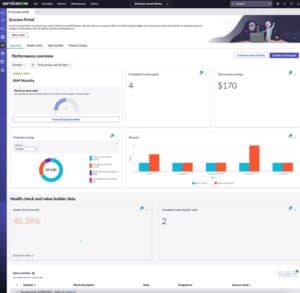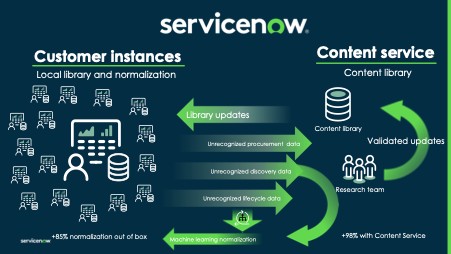Step 1: Get Started. The Path to Getting the Most Out of Your SAM Program in ServiceNow.
Implementing a SAM program in ServiceNow provides organizations with a systematic method to monitor, manage, and optimize their software assets. To get the most out of your SAM program, it is crucial to adopt a phased approach, generally categorized into the following steps: Crawl, Walk and Run. This step-by-step process enables organizations to progressively improve visibility, minimize risk, and increase operational efficiency.
ServiceNow SAM provides a portal view of Success in the Software Asset Workspace to track the progress of your Software Asset Management (SAM) application with success milestones, options to assign activities to monitor milestone achievement, perform health checks on your software, maximize the use of SAM capabilities, and mature your SAM program with predefined items.
Mature your SAM program with predefined maturity items
Program maturity is categorized into three phases: Crawl, Walk, and Run. To help you improve the value return of your SAM program, including processes, features, and capabilities within your organization, you can link these maturity items to success goals and value-creating tasks to track and report on improvements in your SAM application over time.

Crawl Phase: Visibility into Software Inventory/Spend
In this phase, you will establish a healthy configuration management database (CMDB), identify tools for discovering software data, and define processes and roles. The focus should be on end-user computing (EUC) or SaaS integrations, where licensing is not too complex and where software discovery sources are readily available.
Perform a CMDB Health Check
A healthy CMDB is essential to the success of a SAM program. Because the CMDB contains all asset and configuration data, ensuring its integrity prevents data issues and improves the effectiveness of asset tracking and lifecycle management.
Steps for CMDB health check include:
- Validate current asset and configuration data: Ensure that the CMDB accurately reflects all current assets and their relationships to services, systems, and applications.
- Ensure that the CMDB is well structured: organize the CMDB with well-defined asset classes, categories and relationships with other IT services, avoiding fragmentation.
- Resolve data discrepancies: Identify and correct inconsistencies or gaps in the CMDB before importing new asset data.
Establish SAM Processes
Click here to access the Software Asset Management Process Guide in Now Create, which provides detailed instructions on how ServiceNow envisions the SAM process, so you can get the most out of your SAM Program in ServiceNow.
Identify Key Stakeholders for the SAM Program
One of the keys to a successful SAM implementation and adoption across an organization is identifying key stakeholders. These can be anyone who will be impacted by the program. Establishing clear communication and obtaining input from these stakeholders can help gain support for the program.
Steps to complete:
- Identify the different areas that will be impacted by the SAM program.
- Identify stakeholders who are involved and who support the program to ensure its success.
- Document and set up a clear communication plan with stakeholders.
Assigning responsibility to each role based on level of involvement in the SAM Program
Establish roles and responsibilities for those who need to perform the functions necessary for the success of the SAM program. Identify the resources who need to be consulted on decisions or informed about results.
Steps to follow:
- Document roles and responsibilities for the SAM Program.
- Review the RACI with stakeholders.
- Finalize and establish a process for publishing and maintaining periodically.
Define SAM Program Success Criteria
Defining the objectives, goals, metrics, and overall success criteria for the SAM program is important because it helps us identify measurable and achievable milestones and report on progress.
Steps to follow:
- Document success criteria.
- Document the metrics and expected outcomes of a successful SAM program.
- Communicate overall success criteria with stakeholders.
Create the software request process for end users
Creating “standard” and “non-standard” software requests is essential to establish a single point of entry for requests and the ability to provision existing licenses if available. The ServiceNow Procurement Plugin, along with the ServiceNow Request Catalog, can be used to provide an example of the software request flow and the mechanism to implement the process.
Steps to follow:
- Work with multiple stakeholders to identify current process and gaps.
- Document the software request process and obtain stakeholder approval.
- Keep in mind that not everything needs to be automated in the early stages. Focus on the steps in the process and, over time, make the process more efficient.
Measure and share the success achieved in the SAM Program
Identify, measure, and share SAM Program successes through Success Objectives in the ServiceNow SAM Module. These success objectives can be used to identify potential and actual savings, as well as the activities required to achieve them.
Steps to follow:
- See the ServiceNow documentation on Success Goals.
- Success goals can be short-term or long-term.
- Establish a process for recording measurable success goals and the activities needed to achieve them.
Establish “spin” activities to capture purchasing information related to software licenses
In the initial phase, full integration into the purchasing system may not be feasible. However, establishing “turnaround” or data import procedures will help to trace the original purchase of the software usage rights back to the original purchase.
Steps to follow:
- Documentation of the procedure for capturing software entitlements acquired from the purchasing system.
- Using the Purchase Plugin to record the purchase in ServiceNow.
Training
Training, both internal for end users and external for SAM resources, is essential to the success of the Program. Successful programs have established standard training materials, short videos, and training classes for end users and their resources, who may receive training from external sources, as well as certification training for specific vendors and technologies.
Steps to follow:
- Documented training materials are available for end users and SAM resources.
- Training on SAM best practices, certifications, and technologies is encouraged to help gain knowledge on general Software Asset Management methodologies.
EUC: Service Graph Connectors
Software license compliance varies significantly between the datacenter environment and the end-user computing (EUC) environment because of the different ways software is deployed and used in each context.
During the initial phase, we suggest focusing on identifying software in the EUC environment, as this information is typically accessible through Endpoint Management Tools in most organizations (e.g., Microsoft SCCM/MECM, Microsoft Intune, Tanium, Jamf, etc.).
Service Graph Connectors enable organizations to integrate data from external systems into the ServiceNow CMDB. They help maintain data accuracy, consistency, and alignment with the ServiceNow Common Service Data Model (CSDM). Explore the links below for more details:
- Service Graph Connector for Microsoft SCCM
- Service Graph Connector for Microsoft Intune
- Service Graph Connector for Jamf
- Service Graph Connector for Tanium
EUC: Standardization
Software data can come from a variety of sources and can therefore have different formats. To maintain a clean software asset database, automatic and continuous normalization will standardize this data. All software data, regardless of source, goes through a normalization process to standardize the installation data from multiple discovery tools. This involves comparing the discovered publisher, product, version, and edition against the ServiceNow Content Library. Matches are recorded in the normalized fields of the Discovery Model table. Additionally, the Content Library adds useful metadata such as lifecycle dates and United Nations Standard Products and Services (UNSPSC) classification.
In short, if there are any unrecognized exceptions, the ServiceNow content service team searches and updates the content library, distributing the updated material to all customers. SAM Enterprise customers also benefit from Machine Learning Normalization, which helps with partially normalized software, where the publisher and product are recognized, but the version or edition is not.
You can opt for the Software Asset Management Content Service, which allows you to submit missing or partially normalized software discovery models for analysis by ServiceNow. Customers receive updated content and rules to improve software normalization.

When is normalization complete?
Never! Software normalization is an ongoing process, as software is constantly being added or removed from your environment. In SAM, scheduled tasks ensure that the normalization process runs regularly for all software discovery models immediately whenever new ones are generated.
SAM customers typically achieve initial normalization rates of ~85% or higher using discovery sources such as SCCM. However, when also opting for Software Asset Management Content Service, normalization rates in excess of 95% can be achieved.
EUC: Use of SaaS via Single Sign-On
The software discovery sources discussed in the previous section, such as MECM/SCCM, Intune, Jamf, etc., provide visibility into the software installed locally on devices in the End User Computing (EUC) environment. However, in today’s IT landscape, end users are increasingly consuming software products that are not installed on any device in their organization. This software is consumed via a web browser and is typically licensed on a subscription basis. This software delivery model is known as Software as a Service (SaaS).
Enterprises can leverage Single Sign-On (SSO) data to gain insights into SaaS application usage by analyzing user authentication patterns. SSO provides a centralized record of when and how employees access multiple SaaS applications, making it easier to track active users, usage frequency, and adoption of different tools. By examining this data, enterprises can identify which applications are being used regularly, which are underutilized, and where licenses may be being wasted. Ultimately, this visibility helps optimize SaaS spend by ensuring compliance with licensing agreements and improving security by detecting unauthorized or unusual access attempts. Additionally, SSO data can inform decisions about renewing or discontinuing SaaS subscriptions based on actual usage trends. ServiceNow SAM provides integrations with the following SSO providers:
- Okta
- Azure AD
These integrations will allow you to download a comprehensive list of all your SSO applications, users, and groups. You can monitor user login data for all connected applications and reclaim unused licenses. Additionally, you can use this usage data to predict future licensing requirements and reduce the number of unused licenses during renewal.
Steps to be completed:
- Follow the required steps in the documentation to create an application/credentials in the SSO provider.
- Configure the integration profile in ServiceNow.
- Connect SSO applications in ServiceNow to start monitoring users and groups who have access to the application.
Create/import entitlements for software products for the end-user
Software entitlements are legal agreements that define the rights to install, use, and distribute software. They outline the specific terms under which an organization can use a software product, including the number of installations allowed, the duration of use, and any associated maintenance or support. Uploading software entitlements to SAM is crucial because it allows you to efficiently track and manage your software licenses. This ensures compliance with licensing agreements, helps avoid penalties for overuse, optimizes software spend by identifying unused licenses, and provides a centralized view of all entitlements, facilitating better decision-making regarding software acquisition and usage.
For many organizations, 80% of their software spend is concentrated with a few “tier 1” software publishers, such as Microsoft, VMware, Adobe, Oracle, IBM, SAP, Salesforce, etc.
In the infancy phase, we recommend focusing on creating entitlements for end-user software products, both in on-premises and subscription-based delivery models.
Steps to be completed:
- Gather rights data from multiple sources.
- Create software entitlements using “entitlement import”, guided entitlement wizard or manually create the entitlement in ServiceNow.
- Repeat this process for multiple publishers and products.
Translated by 4Matt Technology from the original The Path to Value for a SAM Program in ServiceNow.
